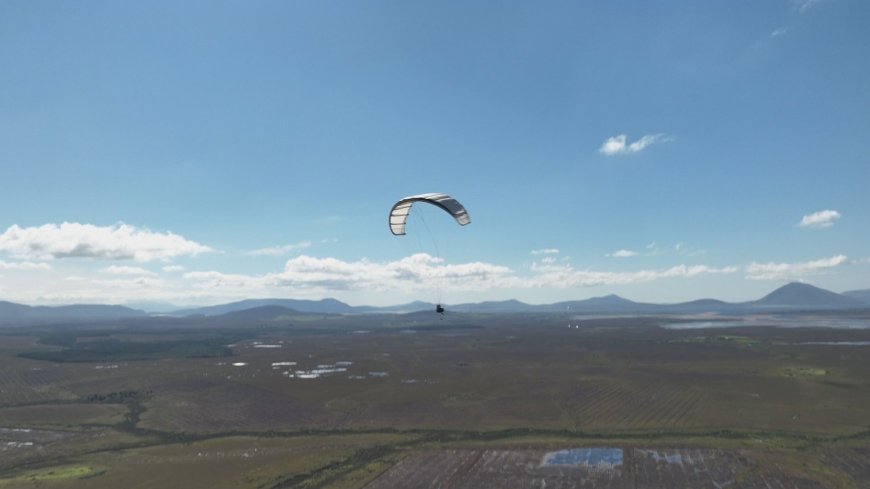Mayo project harnesses wind power with kites
A project in Co Mayo is using kites to generate renewable electricity, offering a new approach in the wind energy sector. Kitepower's innovative system utilizes high-altitude winds to produce electricity efficiently and can be deployed quickly and easily in various locations.

A project in Co Mayo is generating renewable electricity through the flying of kites, which its operator has described as a potential \"game changer\" in the wind energy sector.
It is being conducted on a bogland just outside Bangor Erris, located on a landscape one might expect in a Star Wars.
The site, which is the first designated airborne wind energy test site in the world is being operated by Kitepower, a zero emissions energy solutions spin-off from Delft University in the Netherlands.
Kitepower's system employs a yo-yo effect, where a kite, measuring 60sq/m is flown at altitudes of up to 425m attached to a rope that is wound around a drum - which itself is connected to a ground-based generator.
The kites can generate 2.5 to 4 tonnes of force on the tether.
The drums rotation from the kite's pull generates electricity that can be stored in a battery system.
The pull from this force then rotates the ground-based drum at a high speed.
This rotation then generates electricity that can be stored in a battery system for deployment wherever and whenever it is needed.
The kites are flown using the knowledge and skills of kitesurfing professionals, combined with a highly specialised computerised GPS-guided steering system.
They fly upwards repeatedly in a figure of eight pattern for periods of 45 seconds.
The flight pattern is important because it forces the kites to behave like sails on a boat, maximising the pull of the wind to increase speed so electricity can be generated.
After 45 seconds, the kites are levelled up so that the pull from the wind is momentarily minimised.
This enables the tether to be wound back in, using only a fraction of the electricity generated when it was being spun out.
The result is a net gain in renewable power at the simple cost of flying a kite.
Then the cycle is repeated, again and again, potentially for hours on end.
Watch: Kitepower's chief pilot Padraic Doherty explains how the kites generate power.
A single kite is currently capable of amassing up to 30 kilowatts of free electricity per hour that can be stored and used later.
The entire system is housed in a 20ft container, making it highly mobile and deployable anywhere accessible by truck.
It requires no heavy foundations or resource intensive towers, and it can be installed almost anywhere in less than 24 hours.
The kites can produce electricity on cloudy days, rainy days and even at nighttime.
Kitepower describes what it is doing in Co Mayo as a potential \"game changer\" in the wind energy sector.
It said kites are twice as efficient as conventional wind turbines at capturing wind energy and can exploit high-altitude winds not accessible by traditional wind turbines.
Head of Operations at Kitepower Andrei Luca said the kites are a useful, mobile, fun technology for delivering renewable energy to remote communities, islands, mini-grids and off-grid locations.
\"We are like grown up kids playing with kites and it has never been so much fun,\" he said.
Mr Luca said Kitepower has \"a vision to one day power islands and remote communities and inject renewable energy directly into the electricity grid\".
\"The wind conditions on the west coast of Ireland allow us to push the limits of our system, making it more robust and reliable,\" he said.
\"If it works in Ireland, it will probably work all over the world,\" he added.
Mr Luca said: \"The testing we have done has helped us refine the system and launch a pilot project with our first commercial customer in the Netherlands - a construction company using the kite to charge electric trucks and excavators in a civil infrastructure project.
\"We are also planning to deploy multiple systems in an array configuration.\"
He added that offshore deployment is the firm’s \"next major milestone\", adding \"Ireland again stands out as the ideal place for this, thanks to its research institutes and testing facilities\".
Kitepower’s airborne renewable energy test site at Bangor Erris has been in operation since September 2023. It was developed with the support of Interreg, the European Regional Development Fund. The German owned renewable energy giant RWE and Mayo Council are also partners in the project.
What's Your Reaction?
 Like
0
Like
0
 Dislike
0
Dislike
0
 Love
0
Love
0
 Funny
0
Funny
0
 Angry
0
Angry
0
 Sad
0
Sad
0
 Wow
0
Wow
0















































































































































































